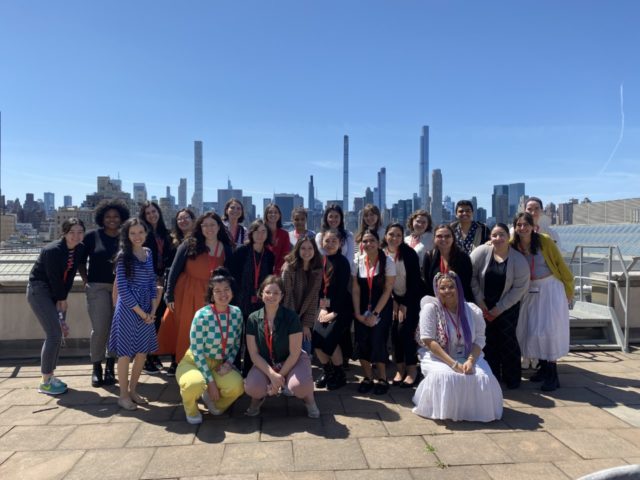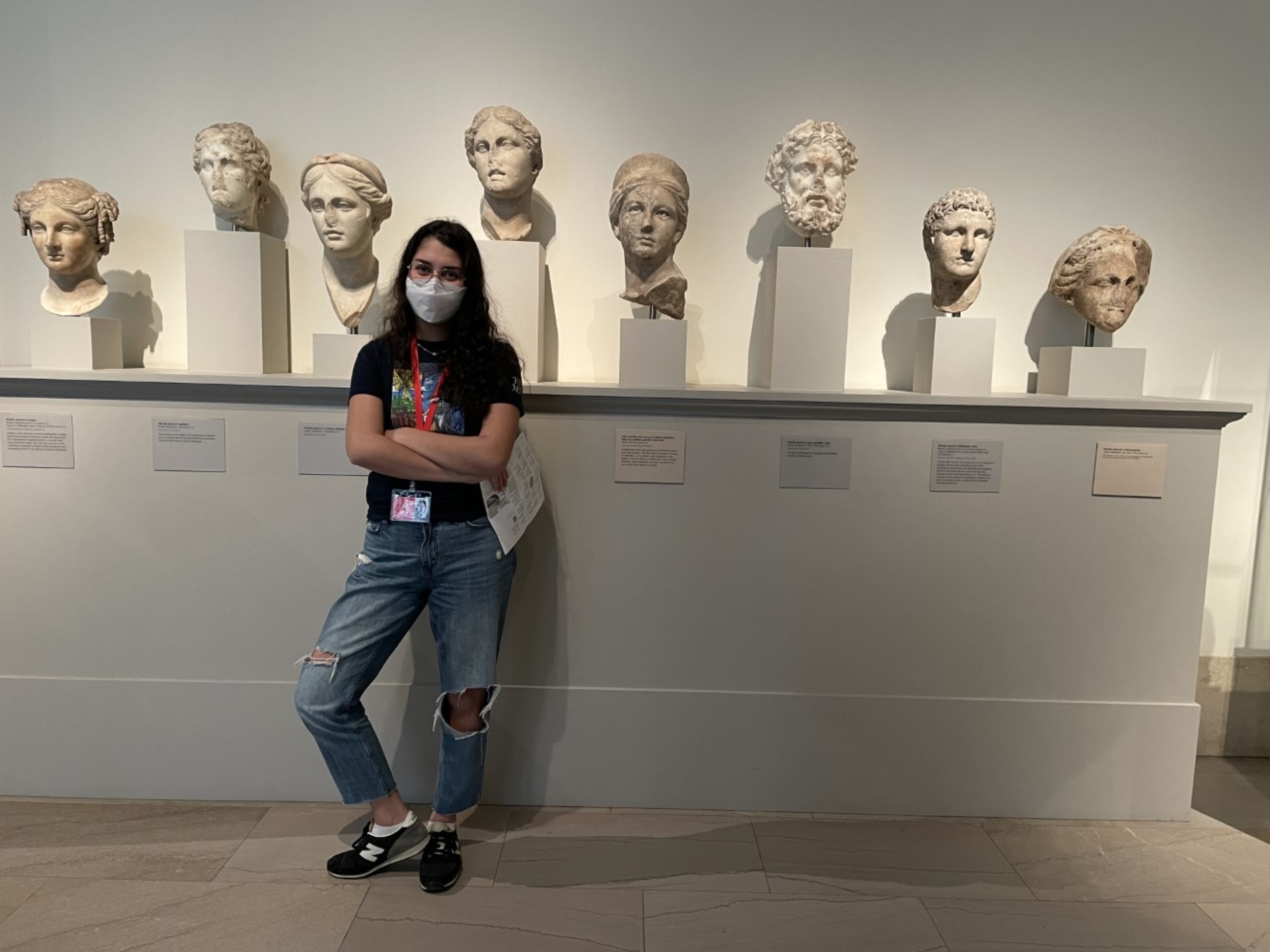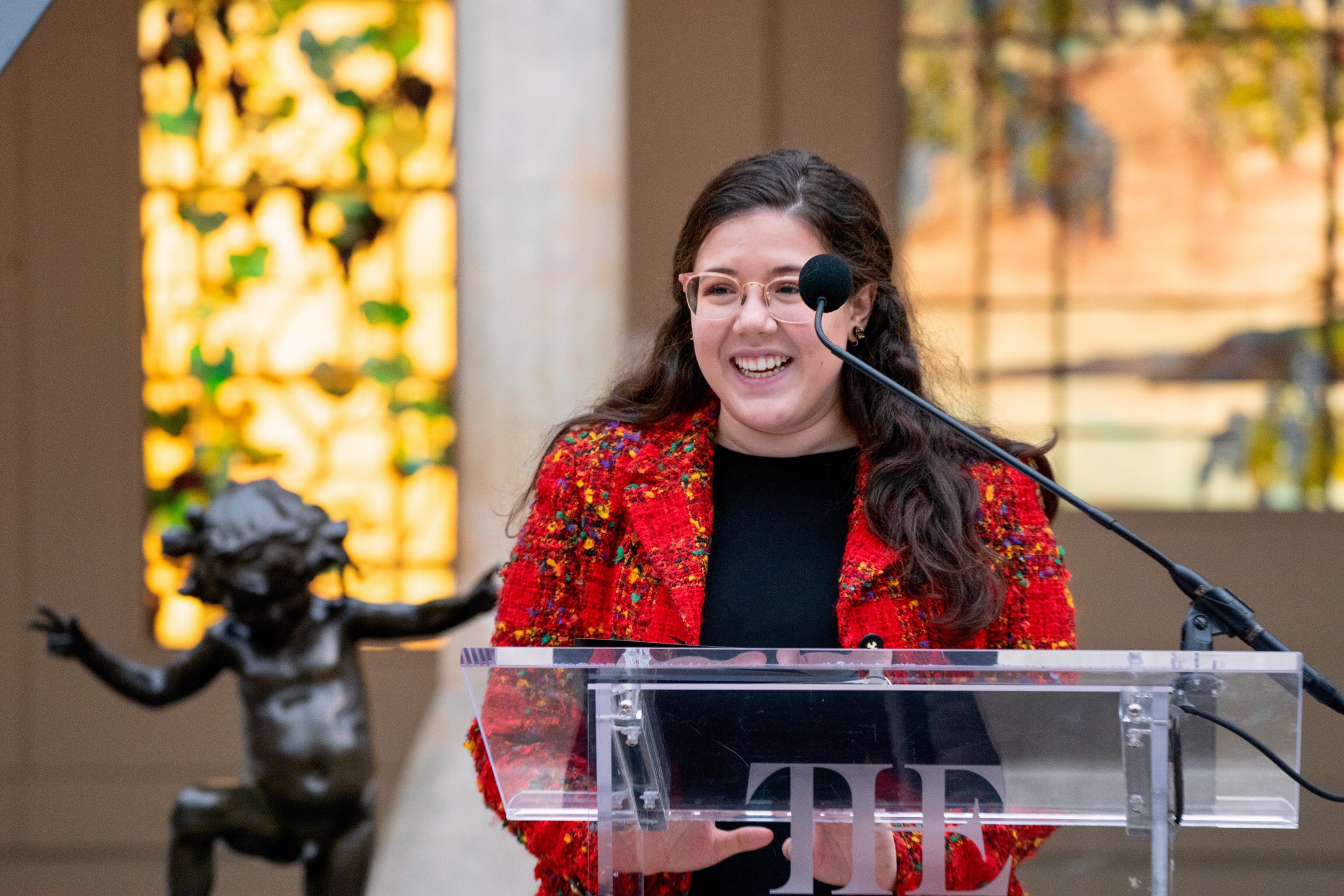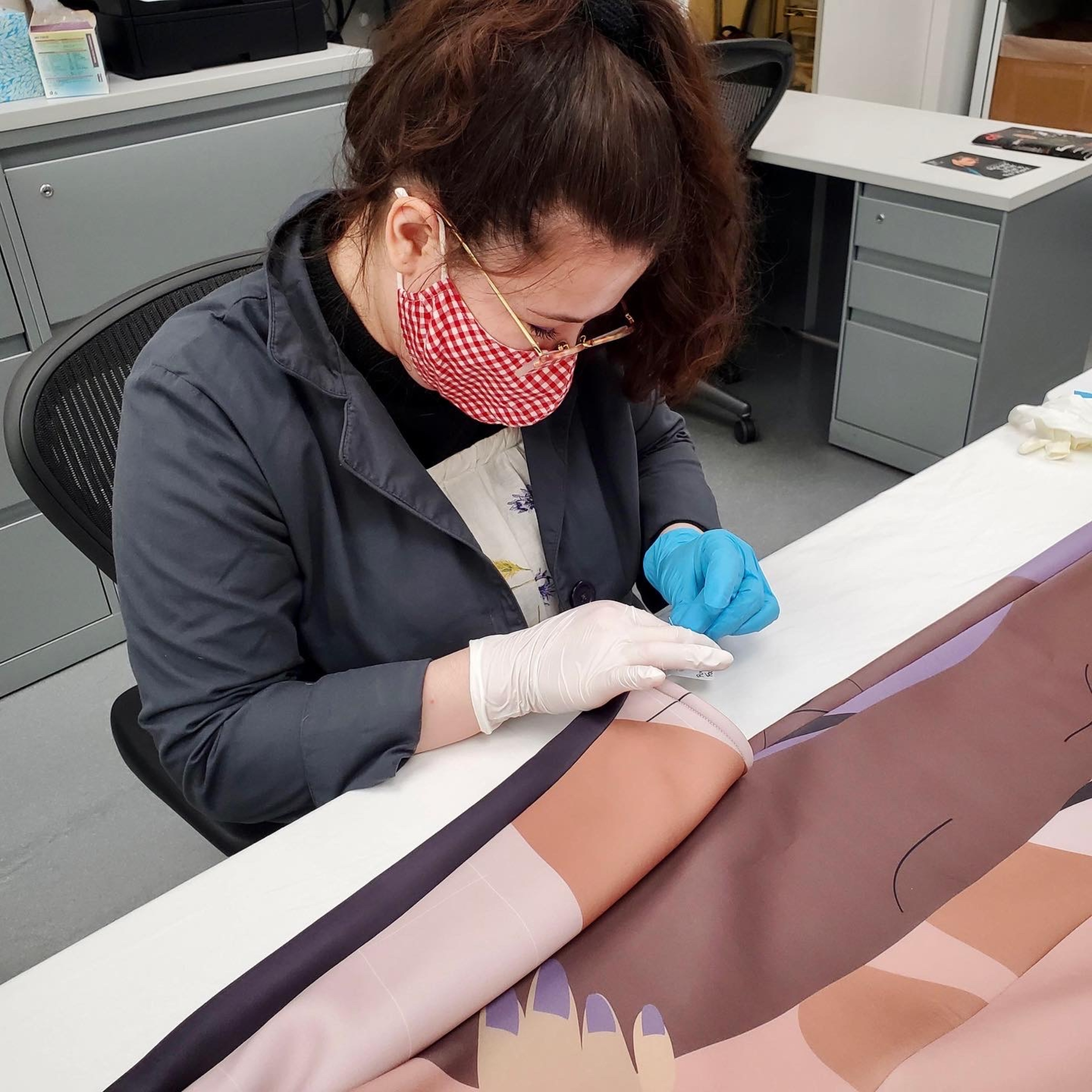Conversation with recent Adrienne Arsht interns at The Metropolitian Museum of Art

“I am thrilled to see this program thriving. The dramatic increase in applications since my gift, speaks for itself. Diana and Cecilia exemplify the value of paid internships. Without financial barriers, they were able to obtain significant internships which will lead to far greater employment opportunities. I believe my contribution is an important investment in our future and leveling the playing field in the arts and elsewhere.” Adrienne Arsht
In 2020, Adrienne Arsht, business leader and impact philanthropist made a generous $5 million gift to the Metropolitan Museum of Art, ensuring that the Met would have paid undergraduate and graduate internship programs starting in Spring 2021. Her donation at The Met impacted the lives of those wishing to pursue a career in fine arts. With the donation, many individuals who were unable to participate in the coveted unpaid internship for financial reasons were able to gain experience and mentorship starting last spring. With Adrienne Arsht’s gift, The Met is the largest art museum in the country to offer 100% paid internships, thus removing financial barriers previously experienced in the arts industry. I spoke with two interns, Diana Montalvo, who interned in the Costume Institute, and Cecilia Orduna, who interned in the Construction department at The Met, to learn more about their experience as Met interns ——and glean any advice they’d offer someone pursuing the coveted internship.
Shaina: I can start off with some background questions for Diana. I’m curious, where did you go to school? What did you study?
Diana: I graduated from NYU in May 2021 and studied media Culture and Communications. Regarding the link to my internship, I did many of my media projects about fashion. I think many essays were done about fashion as a means of communication. One of my projects was coding a video game related to the fashion history. With the game, users could go and click through a seamstress’ workshop and make historical garments. That game, and its inspiration, led me to do an internship at the Costume Institute. I knew I loved museums, and I was interested in the Costume Institute because I was fascinated with costume history and its relationship to museums.
Shaina: That’s awesome! I don’t know many other museums with a Costume Institute like the Met. In my opinion, the Met Gala and its ties to the Costume Institute make it one of the most prestigious costume institutes in the world. Cecilia, would you like to introduce yourself? Where are you from, and where did you go to college and study?

Cecilia: I am from Long Island, New York, and studied at Stony Brook. I’m finishing my master’s at Columbia in Civil Engineering and Construction Management this semester.
Shaina: What made you decide to intern at the Met?
Cecilia: I had previously done a different internship. I got to work at the Studio Museum in Harlem. Over there, they have a lot of ongoing work with the Museum of Natural History, and that was the first time I was exposed to museum construction. It fascinated me; I liked museums and felt it would be fun to continue that passion. I found out that the Met had an internship with the construction department!
Shaina: Diana, I can imagine that the Costume Institute is very different from the construction department at the Met. What was your typical day like?
Diana: I felt really supported as an intern in the department. I worked at the library and collections departments, so I split time with them between Wednesday and Friday. On Wednesdays, I was in the library and learned different things like how to organize metadata and best support researchers coming in and things like that. They wanted me to try everything within the department at least once in collections. I made mounts for objects, searched for specific objects to give curators more information about their history, thought about how to process acquisitions, how new items came into the museum, how to choose which items the museum should purchase, and the list goes on and on. It gave me a framework about how an institution approached acquiring items.
Shaina: I don’t have a background in fashion; I study art history. Is the acquisition process for the Costume Institute different from a typical acquisition of art? For example, does the department look at specific pieces from fashion houses or colleges like the Fashion Institute? What is the process like?
Diana: I think the department does a bit of both [looking at fashion houses and colleges]. But I think the unique thing about the Costume Institute is they are forward-thinking with designers and researchers. While they have an incredible historical collection, they also have to be knowledgeable about what just hit the runway, what people are super excited about because a piece is one of a kind, and if someone’s going to buy it. So often, you’re making decisions a lot sooner than other departments. They [traditional art acquiring departments] look towards a piece’s historical precedent when acquiring an item, whereas the Costume Department has to jump on a piece that came out this season. We have to think it will be relevant in 20 years, which is a more complicated and very different frame of mind when approaching a collection.
Shaina: With art, you see the style and how the piece has been impacted by different periods like the Renaissance. For you, you have to judge, “is this an iconic piece that will stick? Is the style still going to be relevant?” I think that’s a monumental task. I had never thought of it like that. Switching gears, Celia, what was a typical day like as an intern with the construction department?
Cecilia: It was different every day. On many days, I would be taken to various construction projects to attend meetings. I was included in a lot of conversations with different stakeholders across the different art and curatorial departments. I learned that other departments have very different concerns than other stakeholders on a construction project, so it was also interesting to gain that perspective. So, my typical day was visiting a site and then researching the history of the construction and the museum. I learned a lot by researching materials available on the Watson library database.
Shaina: Are there any specific construction projects going on right now concerning renovations to the Met?
Cecilia: Definitely. A few exciting things happened in the construction department while I was there. They’re starting the demo for the Michael C. Rockefeller Wing, which is the main project they have going on. And then the ABC skylight project, which is wrapping up. With the ABC skylight project, I got to tour the site and go on the museum roof, which was pretty cool. And they chose a new architect to remodel the modern art wing. So that was exciting to learn about and see why the architect won out versus other candidates.

Shaina: I feel like there are so many different components. This isn’t something that will be in storage or a closed facility as the costume institute collection. The Construction department has dealt with spaces in the public eye for decades. Diana, you introduced the First Lady at a press interview to open the spring Costume Institute, what was it like? What did you do to prepare for that moment? And was that something that you ever thought you’d experience as an intern?
Diana: Absolutely not. It was a surprise. I had actually finished my internship the week before. So I got an email on the Thursday following that said, “Hey, on Monday, can you introduce the First Lady?” And so I communicated with my advisor and the education department because they were leading interns. So I introduced the First Lady, but three other interns also got to tour the exhibition.
Regarding preparation, I found out Thursday and had to have my bio ready by Friday and the first draft of my remarks on Saturday. And my remarks were approved by the White House Communications team. I thought the communications team was going to write the introduction, and I was just going to read it, but the First Lady always asks that interns introduce her in their own words, which I think is lovely.
Shaina: That’s really sweet. I know she’s very into education and probably views internships as integral components of showing what you have learned and how you apply your knowledge to a developing career. Was there any ribbon cut, or was it just walking through the institute after?
Diana: There was no ribbon-cutting, but we had remarks from the museum director and the curator, then I introduced the First Lady, and she spoke. Her speech was in line with what the exhibition focused on, an anthology of American fashion. After that, we did a tour with the curators.
Shaina: Before Spring 2021, the Met didn’t provide fully paid internships, to my knowledge. What did Adrienne Arsht’s generous gift to the Met allow you to do? Without the donation, would you have still pursued an internship at the Met?

Cecilia: It is really great that they offer paid internships now. Instead of taking on another job, I can do this internship.
Diana: I was actually an intern in Spring 2020 when the world fell apart, and I could only pursue that internship when it was unpaid. Because I was an RA in college, I had free housing and a free meal plan, which was a very purposeful decision because the college expense was just so significant for my family. And so, because of the flexibility that an RA role gave me in terms of just being able to live on campus and eat, I was able to do the internship. I don’t think I could have worked at the Met if I hadn’t been an RA. So I was in a unique position because I had a full-time job, and they let me do the internship simultaneously.
Shaina: That must have been a crazy schedule. What were your hours like? Were you remote for part of it to balance the full-time and the internship?
Diana: I was in person at this job two days a week. [The Met is in person just as a requirement for two days]. And then I got to work remotely at the other job one day. So I did those 14 hours at home after office hours and on the weekend, just because I finally got my dream internship at the Costume Institute. So I was willing to do whatever it took to balance the job and internship because the Met position was one of those experiences I kept applying to try to get into it. And once I got it, I was like, I have to do it. Because it really is one of the few places you can focus on dress history.
Shaina: Definitely, it’s a coveted, iconic internship. So what was your biggest takeaway from the internship? On the website, the Met advertises that interns experience mentoring and professional experience, and I find that mentorship can really mean a great deal when starting your career. So, what was your biggest takeaway?
Cecilia: I thought it was really great because they offered intern-mentor lunches where we got to talk to important people in different departments. It was fantastic to get a closer view and hear why they do what they do the way they do it. Also, every week, we had different weekly intern seminars. Those seminars were great because we got a sneak peek into the other departments. They told us, “This is the path in life I took to get to where I am now.” So I think it was an excellent chance to explore other career paths.
Diana: Yeah, I think there’s like kind of breadth to the internship that is insane to me because you’re constantly meeting new people. They want you to get in front of as many people as possible to learn about a museum’s different functions and see where you might want to land. As far as my program experience, my advisors are lovely. And I think they were excited to have interns and tried to teach us as much as possible. They were so sweet, like goodbyes with a card and cookies level of sweet. I think they really love having people, which is a great experience to feel like your learning isn’t impeding in any way.
Cecilia: Yeah, it’s like everyone I met at the museum wanted to take the time to talk to me and hope I was like learning everything I could. It was so super nice.
Shaina: I feel like people are friendlier than you’d expect, especially when starting out. If you’re asking for help or just advice, people are very open to that. So having that at the internship is definitely reassuring. How was it working with your cohort of interns? Did you do any bonding activities? Did you feel like you were surrounded by a diverse and inclusive group? I am interested in Diana’s experience because she experienced unpaid and paid internships at the Met. I feel that the program might have been more diverse once the internship was paid.
Diana: I think when we were being paid, I did see a big difference as far as who was able to do the internship. There were such diverse perspectives in the second cohort, and I could feel a big difference. I think we were more prepared to have conversations around diversity and equity.
Shaina: So, how did you get to know the cohort? Were you only with the people in your department? Or was it a multi-department function where you met interns from all over the museum?
Cecilia: I think the Friday intern sessions helped facilitate intern relationships greatly. The first week we did an intern scavenger hunt; I think that was an excellent way for us to just break the ice with each other, running around the museum. That was a lot of fun. And then, towards the middle of the program, everyone just started going to the cafeteria on Fridays for lunch at the same time. That was a really good time for all of us to talk and chill out for an hour.
Shaina: Those programs seem so fun! The Met received a record 200% increase in applications for spring 2021 from the previous year. I’m sure that the 2022 program was just as competitive, so what’s your biggest piece of advice for someone that wants to intern at the Met?
Cecilia: I’d say take the time to look through the descriptions of all the different departments. Sometimes, it’s like, “Oh, I’ve never heard of this before,” but after going through the entire book, you’re like, “This sounds so cool.” So many people said, “If you’re majoring in this, you might be interested in this.” The Met has jobs and positions for pretty much every single major.

Diana: As someone in media, I felt like that first internship round, I really stuck myself in like, “I have to do development, I have to do digital because that’s what I know. And they’ll not accept me if I don’t do that.” And I think through school and doing my own projects, It was like, “No, I can do something in collections, I can do something in curatorial.” I feel like people without an art history background don’t expect to be able to find their place in a museum, or at least that is how I felt. So my advice is to just go for it and show how your unconventional background is an asset. Definitely have fun with the application.
Shaina: Definitely, and also, never sell yourself short. Most places can use a skill you have to offer. So what are your plans now? What will you carry with you to the next part of your career?
Cecilia: Yeah, so I’ll start my job as a construction project manager at the end of June. I think I took away a greater appreciation for the other perspectives on construction projects because I was often on the other side. At the Met, I’ve experienced the owner side of things. Now I’m going to be on the consultant side. Having access to such a different perspective will make me a lot more compassionate in my work.
Diana: I am currently at a nonprofit for historic houses. And I think having collections in library experience makes me a better communicator with House directors. It makes me more understanding of what our function is and what a house museum’s function is.








